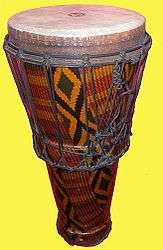Ashiko
The ashiko[1] is a drum, shaped like a tapered cylinder (or truncated cone) with the head on the wide end, and the narrow end open. It is made of hardwood and generally has a goatskin hide. It is played with the hands, and tuned by ropes. Ashiko drums – or variants thereof – are traditionally found in West Africa, as well as part of the Americas.
 | |
| Percussion instrument | |
|---|---|
| Classification | Membranophone |
| Hornbostel–Sachs classification | 211.251.1 (Open ended conical drum) |
| Developed | Yoruba |
History
The origins of the ashiko drum are traced to the Yoruba culture in (mainly) present-day Nigeria and Benin, West Africa. The word “ashiko” is also traced to a word in the Yoruba language meaning either “drum” or (with tonal difference) "time-frame" or “freedom”. The drum has a long tradition in Yoruba culture, where the drum functioned in community celebrations, as well as a “talking drum”. Traditional ashikos were/are hand carved from a single lug of wood and were not straight cones.
Perhaps because Yorubaland and surrounding areas were strongly involved in (affected by) the Atlantic slave trade, drums with similar forms and characteristics are historically found in Afro-Caribbean and Afro-Latin American cultures and traditions. In Cuba specifically,“ashiko-like” drums can be identified in the drum known as “bocú” in Eastern Cuba, as well as one of the drums (a solo drum) used in the Abakua secret society. Drums similarly shaped to the ashiko - including the "truncated cone" form - can also be found in Afro-Colombian music (the Tambor Alegre in the Caribbean region of Colombia), as well as in Afro-Brazilian music, such as the Timbau. The latter, from the Bahia region, tends to have however synthetic heads and is, unlike the ashiko, tuned by pegs.[2]
The African/Nigerian ashiko as such first got disseminated and popularized in some circles in the US in the 1930s, after Nigerian drummer Moses Mianns migrated to New York in the 1930s. The ashiko got popular on a much wider scale in the US and elsewhere in the 1950s with the popularity in the West of Yoruba musician Babatunde Olatunji, whose African music and dance troupe travelled and performed, including ashiko and other drums. Since then the ashiko got included more in local drum circles, also in the US and elsewhere in the Western world, though it remains there in the present relatively less popular or widespread than the djembe, conga, or bongos drums.
Characteristics
Some call the ashiko a "male" counterpart to the djembe, though this is contradicted by references to the relatively matriarchal Yoruba culture. Also it being regarded as "between a djembe and a conga" is seen as wrong, and disrespectful to the ashiko itself and its own tradition, including a distinct playing technique, different from the djembe or conga. It is a drum in itself and not a counterpart or derivative. There is, besides this, a geographical difference, as the djembe's origins are associated with the Mali empire (Guinee and Mali region), and the ashiko's as said with Yorubaland.
Superficial sonic similarities with the djembe relate to the goatskin head it has in common with it, but the longer, cylinder form of the ashiko drum makes the bass tone “deeper” than that of the bowl-shaped djembe, while in general the sounds – most speak of three different tones of the ashiko – are different (a bit softer) when compared to the djembe. Some percussionists argue that the ashiko knows more "middle tones" when compared to the djembe.
Modern ashiko drums produced in the West are often made of vertical staves. Like other drums they can be purchased with the standard 8, 10, or 12 inch diameters of the hides. Ashikos tuned by lugs and metal tacks are nowadays also produced. Some manufacturers use cow hide to make the ashiko resemble an Afro-Cuban conga.